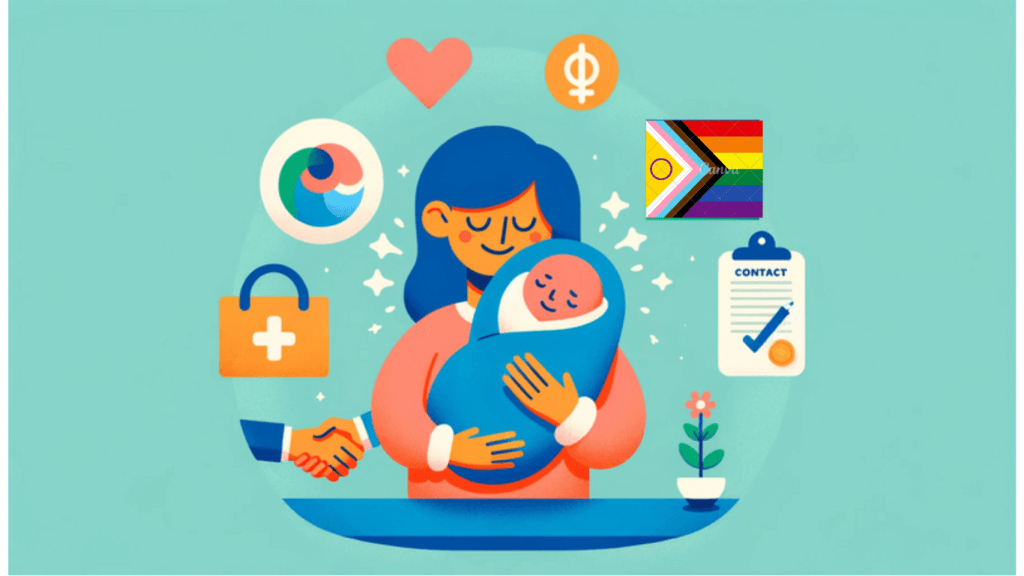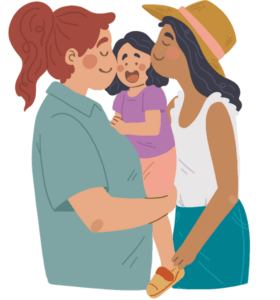Being Queer and Becoming a Parent: the Possibilities
Meena
This resource is intended to be an indicative primer on a few (non-traditional) parenting routes for queer individuals and couples. This is not an exhaustive or foolproof guide. Given the ever-changing nature of legislations and government regulations around trans and queer lives where the provisions mentioned here are likely to change with time.
Surrogacy:
Surrogacy is the process through which a person with a healthy womb (the gestational carrier* or surrogate*) is informed and willingly carries a pregnancy on behalf of an intending couple or parent. The biological matter of the intending parent/s (embryo/egg) goes into the formation of the foetus carried by the surrogate. The child is thus considered the biological child of the intending parent/s. There are variations to this process where the surrogate may also be the egg donor and share DNA with the child.

Surrogacy has been categorized based on compensation for the gestation period:
- Commercial – where the gestational carrier is financially compensated for their labour and delivery
- Altruistic – where the gestational carrier is not compensated in money or kind; they agree to carry and deliver the child out of compassion, altruism, or the willingness to support family members in need
Through the process of commercial and altruistic surrogacy, a handful of queer couples – primarily cis same-sex couples – in India were able to have (biological) children until the legal ban on commercial surrogacy and regulation on altruistic surrogacy through the Surrogacy (Regulation) Act and ART (Regulation) Act in 2021. Unfortunately, the current provisions make surrogacy highly inaccessible to most queer people. There are a few possible exceptions based on cis-ness and passing.
Who in the queer community can access surrogacy under the current system?

- Cis-queer women (or those who legally and socially pass as cis-women) between the ages of 35 and 45 who have been widowed or divorced (from a legally sanctioned heterosexual marriage). The eggs of the intending woman are fertilized to create an embryo inseminated to the surrogate. With its limitations, this provision could be accessed by cis-LBPQA* women who meet the criteria.
- Queer persons in cishet-passing legally sanctioned marriages where the AFAB person is between the age of 23 and 50 and the AMAP person is between the age of 26 and 50. They do not have a surviving child biologically or through adoption or through previous surrogacy and have medical proof of gestational difficulty. With its limitations, this provision could be accessed by partners in lavender marriages*, cishet-passing intersex persons*, and cis-LGBPQA* persons who meet the criteria.
Notes for queer parents considering this option:
- Identify an altruistic surrogate who fulfils extensive legal requirements and is willing to carry the child to term.
- Learn the legal requirements to be fulfilled for certification as an intending couple;
- Learn about the provisions penalising intending parents and the grounds for the same while considering this arrangement and preparing for it.
- Despite the surrogacy being non-commercial, be prepared for expenses ranging from court fees to 36-month medical insurance for the surrogate.
- Understand that this is a process that involves the burden of medical proof of gestational difficulty, the involvement of a government medical board for validation, an essentiality certificate* to be submitted to a first-class judicial magistrate court, and a court order to register the child’s proof of birth and parental rights.
- Account for the difficulties that may arise from queer persons trying to pass through a highly regulated process set up for cis-het married couples, widows and (women) divorcees.
Adoption:

Adoption is the process through which prospective parents gain legal parenthood of a child without being biologically related. As a result of being governed by the Juvenile Justice Act 2015 and The Hindu Adoption and Maintenance Act 1956, legal provisions of adoption apply only to Indian Hindus, Jains, Sikhs and Buddhists outside Jammu and Kashmir and Ladakh. Christians, Muslims, Parsis and Jews do not have personal laws that allow adoption. Through other provisions, they may gain foster care* or legal guardianship of a child.
While non-legal adoption practices and legally recognised kinship adoption processes exist, this section focuses on the possibilities for prospective parents who seek to legally adopt a child that they do not share a biological relationship with. CARA (Central Adoption Resource Authority) is the regulatory body that governs this process.
Through the process of adoption, a legally married heterosexual couple, a single woman or a single man can adopt a child. The provision for queer adoptive parenting has been contested in courts, discussed as part of court proceedings on marriage equality and debated by adoption authorities and agencies. While there is yet to be a legal provision that allows or prohibits queer adoptive parenting, the actuality of it is varied. Prospective trans parents have repeatedly been denied access to the legal adoption of children. This discrimination has been acknowledged by state bodies occasionally and may give way to instances of legal adoption by trans parents in the future. Same-sex parents have been denied the provision to adopt as a couple in courts and by agencies. While some adoption agencies have an active stance against allowing a cis-queer person to adopt under the provisions available for single men and women, there have also been instances of successful adoption by cis-LGBPQA persons as single parents.
Who in the queer community can access adoption under the current system? What are the possibilities?

- An unmarried cis-queer (passing) woman can adopt a child of any gender. This provision could be accessed by single cis-LBPQA women. This could also be accessed by one of the partners in a same-sex relationship. While both partners could raise the child, only one of them would be legally recognised as the parent.
- An unmarried cis-queer (passing) man can adopt a male child. This provision could be accessed by single cis-GBPQA* men. This could also be accessed by one of the partners in a same-sex relationship. While both partners could raise the child, only one of them would be legally recognised as the parent.
- In the case of a couple with one trans partner and one cis partner, the cis partner could adopt a child as a single parent. While both partners could raise the child, only the cis-partner would be legally recognised as the parent.
- Queer persons in cishet-passing legally sanctioned marriages could adopt a child of any gender. With its limitations, this provision could be accessed by partners in lavender marriages, cishet-passing intersex persons and cis-LGBPQA persons.
- A version of lavender marriages where two queer persons enter a cis-het passing platonic marriage with the intent of co-parenting children is a possibility.
Notes for queer parents considering this option:
- The age difference between the child and the prospective parent cannot be less than 25 years.
- The choice of adoption agency and an understanding of their stance on queer parents is crucial.
- Adoption is a highly regulated process with many steps that involve the close examination of the prospective parents’ lives, finances, lifestyle, household and support system.
- The process involves a high level of uncertainty.
- Account for the difficulties that may arise from queer persons trying or not trying to pass through a highly regulated process set up for cis-het married couples and single parents.
- Given that inspections and checks happen beyond the initial placement of the child in the parent’s house, queer parents may have to assess and decide on the extent to which they exercise their visibility as queer persons.
Pregnancy and Assisted Reproductive Technology*:
Traditional pregnancy results from sexual intercourse that involves the penetration of a vagina by a penis. Conceiving through that is a possibility for most cis-queer persons based on their reproductive health and trans-queer persons based on the stage of their medical-surgical transition.
A transman may be able to conceive and carry a foetus based on the health and fertility of the hormones and organs involved in the fertilisation of sperm, embryo formation, implantation, gestation and delivery. This is possible before the medical and surgical transition. In many cases, it is also possible when the medical transition is stopped for a few months after starting. Many instances of this exist around the world. While testosterone may stop ovulation, egg reserves may still be available and viable. Before surgical transition, if the medical transition is paused for a few months, it may be possible for transmen to conceive and carry a pregnancy. The child could be delivered vaginally (through the birth canal) or surgically (through caesarean section). This is a medically intensive process that requires reproductive experts who can assess the viability of pregnancy based on the stage of transition, advise on risks involved and provide trans-affirmative pregnancy care. Starting or resuming medical and surgical transition after pregnancy is possible. Those who wish to donate or preserve their eggs could also have them frozen before or during their transition.
A transwoman may be able to produce viable sperm based on the stage of medical and surgical transition. Those who wish to donate or preserve their sperm could also have them frozen before or during their transition. If a transwoman is in a relationship with a ciswoman, the ciswoman could opt for artificial insemination* or in vitro fertilisation (IVF)* using the transwoman’s preserved sperm. While both of them could raise the child together, this process of assisted reproduction is likely to only recognise the ciswoman as the legal parent.
Based on the stages of their transition, a transman and a transwoman could conceive a child through penetrative sexual intercourse. Intersex persons could seek the support of an informed reproductive expert to understand the possibility and process of contributing to or carrying a pregnancy.
While these options may be possible, the process of conceiving and carrying a child through traditional pregnancy may trigger gender dysphoria and body dysmorphia for trans persons. Health systems around pregnancy are designed around maternity, a social reality that adds to the challenges for prospective biological parents who are trans. For cis-lesbians and cis-gays attempting a traditional pregnancy through a lavender marriage or a similar consensual agreement, the process of sexual intercourse involved could still be a distressing experience.
The use of assisted reproductive technology (ART) such as artificial insemination and in vitro fertilisation (IVF) by queer persons to conceive a child could be an alternative for those with the required resources. Becoming a parent through the use of ART in India is a provision legally recognised for married heterosexual couples and single women.
Queer persons in cishet-passing legally sanctioned marriages could make use of the option of seeking reproductive assistance for fertilisation, insemination, donor eggs or donor sperm. This process could be accessed by partners in lavender marriages, cishet-passing intersex persons and cis-LGBPQA persons who meet the criteria.
Single cis-LBPQA women, pre-transition transmen and those who legally and socially pass as cis-women could make use of the option of seeking reproductive assistance for fertilisation, insemination, donor eggs or donor sperm. They could raise the child as a single parent or with their partner. However, the person who delivers the child through ART will be legally recognised as the child’s sole parent. Additionally, the social reality of having a biological child through ART involves many challenges as many institutions ask for details of the biological father (the sperm donor) who is often not a part of the child’s life.
As surrogacy is no longer an option open to single men, ART provisions cannot be availed by most cis-gay men and couples.
Queer families and queer imagination:
While the article has discussed some legal and medical processes through which trans and queer persons can become parents, it could help to remember that queer families take many forms. Indian trans communities have a rich history of building close-knit, familial relationships and living as a unit. Many queer people find care, support, meaning and safety in their chosen/found families. They also serve as a reminder that forming a loving family does not have to involve children. But for those who wish to raise children, strong queer imagination and some planning can make way for some inventive ways to parent children.
While this primer could serve as a starting point to navigate the legal recognition of parenthood, the domestic reality of setting up a family could go beyond that. There are trans-queer families in India with more than two parents involved in the upbringing of a child. There are single gay parents and couples who were able to avail of surrogacy and become biological parents before there was regulation allowing or prohibiting it. There are prospective trans parents who are currently contesting trans-exclusionary practices in the adoption system. There are same-sex couples, who are exploring the possibility of each partner adopting a child and raising the children in the same household as siblings. Going beyond the expectation of sharing a romantic bond, there are instances of two queer individuals coming together to co-parent a child without being a romantic couple. With or without children, trans and queer people have found ways to build loving families and it is our hope that this primer points to some possibilities within the existing legal framework.
However, please note that this primer does not provide expert legal/medical advice. There is no guarantee that the possibilities mentioned here will be recognised when you approach public systems. Even if the provisions were possible, there may be barriers to availing them based on financial stability, caste and religious identity, migration, documentation, need for a support system, and access to medical and legal expertise. This primer is best used as a starting point for your own research and planning. Finding trans and queer affirmative/informed medical and legal practitioners will be an asset to your journey. Connecting with other queer parents and prospective parents would also help you feel supported. Stay safe. Be imaginative. Plan ahead. We wish you the very best!
If you would like to understand some of these possibilities better, reach out to us via email (contact@safeaccess.co.in). We will try to answer your queries to the best of our ability.
About the Author:
Meena is a queer gender security worker. She firmly believes that individuals should not have to function as entire systems and is finding her way through creating effective response systems.
Sources:
This resource was created through lived and shared experiences from the trans-queer community in addition to a review of public literature. The following are links to articles and legal documents that were used as sources and/or indicators of public narratives.
On Surrogacy:
https://www.indiacode.nic.in/bitstream/123456789/17031/1/A2021-42%20.pdf
https://www.lawrbit.com/article/analytical-study-on-surrogacy-regulation-rules-2022/
On Adoption:
https://theprint.in/opinion/where-are-indias-queer-parents/608267/
https://cara.nic.in/PDF/adoption_regulations_2022_2709.PDF
https://www.legalserviceindia.com/articles/hmcp_adopt.htm
On Pregnancy and Assisted Reproductive Technology:
https://www.givelegacy.com/fertility-and-sperm-freezing-trans-women/
Note: We do not endorse or guarantee the accuracy, completeness, or usefulness of any information provided. Consult your healthcare provider before making any healthcare decisions or changes to your treatment based on information obtained from this platform. In case of a medical emergency or urgent situation, please seek immediate medical attention or contact your local emergency services.
